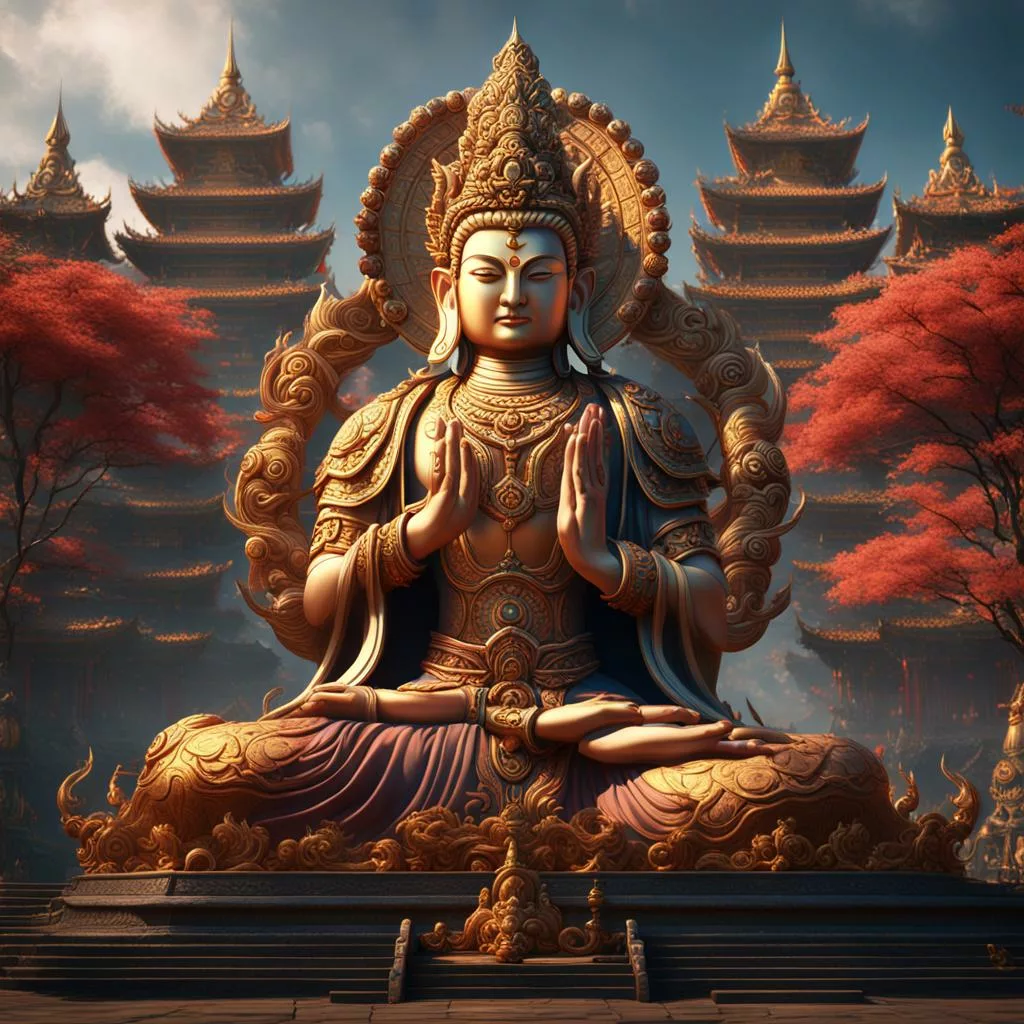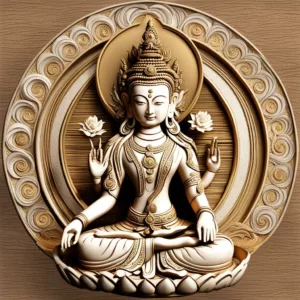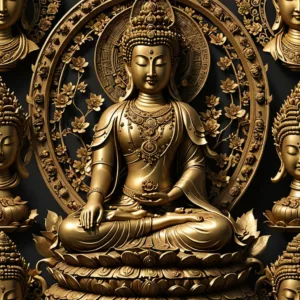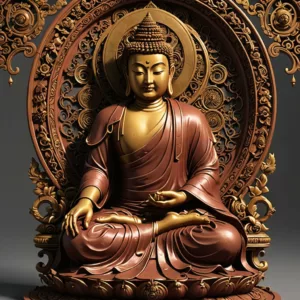
The bodhisattva, meaning ‘awakening being’ is a follower of the Buddha’s Mahayana path. He or she has developed 2-fold bodhicitta: wisdom, seeing emptiness directly in mediation, and compassion for the suffering of beings.
Table of Contents
Bodhisattva Summary
| Entity | Description |
|---|---|
| Bodhisattva | An enlightened being in Mahayana and Vajrayana Buddhism who postpones their own complete nirvana to guide all beings towards liberation. |
| Buddha | A fully enlightened being who has achieved liberation from suffering and the cycle of rebirth. |
| Nirvana | The state of liberation from suffering and the cycle of rebirth, the ultimate goal of Buddhist practice. |
| Compassion | A central Buddhist virtue emphasizing empathy, understanding, and the desire to alleviate suffering in others. |
| Skilful Means | The wisdom to adapt one’s teaching and actions to best suit the needs and understanding of different individuals. |
| Six Perfections | Generosity, ethical conduct, patience, joyous effort, mindful concentration, and wisdom, qualities cultivated by Bodhisattvas on their path to enlightenment. |
| Tenth Bhumi | The highest level of a Bodhisattva’s development, just before achieving Buddhahood. |
Relationships:
| Relationship | Description |
|---|---|
| Aspires to become | A Bodhisattva’s essence is their vow to achieve Buddhahood for the benefit of all beings, not just for themselves. |
| Driven by | Deep compassion for the suffering of others motivates Bodhisattvas to dedicate themselves to the path of helping others achieve liberation. |
| Employs | Bodhisattvas utilize various methods and teachings, adapting their approach to best reach different individuals and overcome their unique challenges. |
| Cultivates | These qualities are essential aspects of a Bodhisattva’s journey, reflecting their dedication to helping others and progressing towards enlightenment. |
| Exists on the path to | This represents the culmination of a Bodhisattva’s development, the final stage before achieving Buddhahood. |
Additional Notes:
- Bodhisattvas are often depicted in various forms, representing different qualities and aspects of their practice.
- There are numerous well-known Bodhisattvas in Mahayana and Vajrayana Buddhism, each with their own unique stories and symbolism, such as Manjushri (wisdom), Avalokiteshvara (compassion), and Kshitigarbha (vow to liberate all beings from hell).
- The concept of the Bodhisattva path serves as a source of inspiration for practitioners, encouraging them to cultivate compassion, wisdom, and skillful means in their own lives and strive to benefit all beings.
Bodhisattva related Terms
Bodhisattva Related Terms
Concepts:
- Mahayana Buddhism
- Enlightenment (Bodhi)
- Compassion (Karuna)
- Liberation (Moksha, Nirvana)
- Great Vow (Mahayana ideal)
- Helping all beings
- Awakened being
- Spiritual guide
- Path of the Bodhisattva
- Paramitas (perfections)
Beings:
- Avalokiteshvara (Quan Yin)
- Manjushri
- Kshitigarbha
- Maitreya Buddha
- Tara (various forms)
Practices:
- Six Paramitas (generosity, morality, patience, effort, meditation, wisdom)
- Meditation
- Helping others
- Ethical conduct
Related Ideas:
- Arhat (Theravada ideal)
- Buddha
- Samsara (cycle of rebirth)
- Dharma (teachings)
- Sangha (community)
- Skillful means (upaya)
- Emptiness (Shunyata)
- Middle Way (Madhyamaka)
Additional Terms:
- Mahayana vehicle
- Bodhisattva path
- Bodhisattva vow
- Awakened mind
- Enlightened being
- Spiritual development
- Liberation from suffering
- Benefitting all beings
How to Identify a Bodhisattva
Identifying a Bodhisattva goes beyond physical appearances; it involves recognizing the altruistic qualities and compassionate actions embodied by these beings. They are individuals who have dedicated themselves to attaining Buddhahood for the benefit of all sentient beings.
They emanate compassion, wisdom, and a selfless commitment to alleviating suffering, making them identifiable by their actions and the profound energy they exude.
How to Pronounce Bodhisattva
Before delving into the profound realm of Bodhisattvas, it’s essential to understand how to pronounce this sacred term. In English, it is commonly pronounced as “boh-dee-SAHT-vah,” with the emphasis on the second syllable. This pronunciation respects the Sanskrit origins of the term, allowing practitioners to express reverence when invoking the name of these enlightened beings.
Bodhisattva Guanyin
Among the revered Bodhisattvas, Guanyin, also known as Avalokiteshvara, stands as an embodiment of compassion. Pronounced as “gwahn-yin” or “gwahn-yeen,” Guanyin is often depicted with a thousand arms, symbolizing the myriad ways she reaches out to help those in need. This Bodhisattva’s compassionate gaze and willingness to assist all beings make her a beloved figure in various Buddhist traditions.
Bodhisattva Meaning in English
In English, the term “Bodhisattva” can be broken down for a clearer understanding. “Bodhi” translates to enlightenment or awakening, and “sattva” means being or essence. Therefore, a Bodhisattva is someone whose essence is dedicated to enlightenment, signifying a selfless commitment to the spiritual journey for the benefit of all sentient beings.
Bodhisattva Statue
Bodhisattva statues are revered representations of these compassionate beings, serving as focal points for devotion and meditation. These statues often depict various mudras (hand gestures) and postures, symbolizing their compassionate actions and wisdom. The presence of the statues in homes and temples fosters an environment of compassion, inviting practitioners to align their hearts with the altruistic path.
Bodhisattva vs Buddha
While both are revered figures in Buddhism, they differ in their motivations and roles. A Bodhisattva is an enlightened being who, out of compassion, chooses to remain in the cycle of birth and death (samsara) to assist all sentient beings on their path to enlightenment. In contrast, a Buddha is someone who has attained complete enlightenment and is free from the cycle of rebirth. While theyshare compassion and wisdom, the Bodhisattva’s journey involves sacrificing personal liberation to guide others.
Bodhicitta
At the heart of the Mahayana path lies the concept of Bodhicitta, often translated as the “mind of enlightenment.” Bodhicitta is the altruistic intention to attain Buddhahood for the benefit of all sentient beings. Cultivating Bodhicitta involves generating a compassionate motivation that transcends self-interest, fostering a genuine concern for the welfare of others on the path to enlightenment.
Bodhisattva Vow
The vow is a solemn commitment undertaken by practitioners aspiring to follow the altruistic path. This vow revolves around the dedication to attain Buddhahood for the benefit of all sentient beings. Reciting the vow is a profound and transformative practice, aligning the practitioner’s intentions with the selfless journey of compassion and enlightenment.
Bodhisattvas List
The pantheon of Bodhisattvas is vast and diverse, with each embodying unique qualities and attributes. The 8 great bodhisattvas are at the top of this list
- Avalokiteshvara
- Manjushri
- Vajrapani
- Maitreya
- Ksitigarbha
- Sarva-nivarana Vishkarmin
- Akashagharba
- Samantabhadra
- Guanyin / Quanyin
- Tara
- White
- Green
- Mahasthamaprapta
- Fukūzenjū
Each Bodhisattva plays a distinct role in the spiritual journey, offering guidance and inspiration to practitioners traversing the path of compassion and wisdom.
Tara Bodhisattva
Tara, often referred to as the “Mother of Liberation,” is greatly revered in Tibetan Buddhism. Known for her swift compassionate action, Tara manifests in various forms to aid beings in times of distress. Tara’s practices are particularly prominent in Vajrayana Buddhism, where practitioners invoke her energy for protection, guidance, and the removal of obstacles.
Bodhisattva Maitreya
Maitreya, also known as the “Future Buddha,” vowed to appear in the future as a fully enlightened Buddha. Depicted with a gentle and compassionate demeanor, Maitreya inspires hope and optimism, symbolizing the potential for enlightenment that exists within all beings.
Bodhisattva Avalokiteshvara
Avalokiteshvara, often associated with Guanyin, is revered for compassion and mercy. Pronounced as “ah-va-loh-kee-tesh-va-ra,” this Bodhisattva is depicted with multiple arms and heads, embodying the boundless ways in which compassion can manifest to benefit sentient beings.
Bodhisattva Ksitigarbha
Ksitigarbha, known as the “Earth Store Bodhisattva,” is revered for his vow to assist beings in the hell realms until they attain enlightenment. Pronounced as “kshi-tee-garb-ha,” he embodies unwavering commitment and compassion, symbolizing the transformative power of selfless actions.
Vajrapani Bodhisattva
Vajrapani, often depicted holding a vajra, is a Bodhisattva associated with the power of the thunderbolt. Pronounced as “vahj-ra-pah-nee,” Vajrapani represents the fierce and transformative energy required to overcome obstacles on the spiritual path. This Bodhisattva’s name reflects the symbolism of the vajra, signifying indestructible wisdom.
Mahasthamaprapta Bodhisattva
Mahasthamaprapta, pronounced as “ma-hah-stha-ma-prap-ta,” is often associated with wisdom and the power of discernment. He complements the compassionate qualities of other his peers, offering practitioners guidance in developing discernment on their spiritual journey.
Bodhisattva Never Disparaging
Never Disparaging, known as Fukūzenjū in Japanese Buddhism, is a unique figure who embodies the principle of respecting and honoring all beings without discrimination. This name reflects the commitment to never speak ill of or disparage any sentient being, emphasizing the universal potential for enlightenment.
Bodhisattva Meaning in Hindi
Understanding the meaning of Bodhisattva in Hindi expands the cultural and linguistic dimensions of this sacred term. In Hindi, “Bodhisattva” retains its essence, representing an enlightened being dedicated to the welfare of all sentient beings. Exploring the meaning in Hindi allows practitioners to connect with the universal principles encapsulated in this term across linguistic boundaries.
Bodhisattva of Compassion
The Bodhisattva of Compassion, often synonymous with Avalokiteshvara or Guanyin, epitomizes boundless love and mercy. This Bodhisattva’s unwavering commitment to alleviating the suffering of sentient beings exemplifies the transformative power of compassion on the spiritual journey.
Bodhisattva Tattoo
For individuals deeply connected to the principles of Bodhisattva, a Bodhisattva tattoo becomes a permanent expression of their commitment to compassion and enlightenment. Whether depicting Avalokiteshvara’s compassionate gaze or Maitreya’s serene presence, these tattoos serve as visual reminders of the aspirational qualities inherent in the Bodhisattva path.
In conclusion, the exploration of Awakening Being encompasses a vast and profound journey that resonates across cultures, traditions, and spiritual practices. From understanding the pronunciation to identifying them, delving into their meanings, vows, and diverse representations offers practitioners a comprehensive roadmap for cultivating compassion, wisdom, and altruism on the path to enlightenment. Whether manifested in statues, invoked through prayers, or etched in the skin as tattoos, Bodhisattvas continue to inspire and guide countless individuals seeking to awaken the innate buddha nature within.
Secrets of Meditation for Anxiety
Like millions of people, you may have suffered from anxiety for years. Meditation, yoga, peaceful music – it never works. It takes too long, and it’s not stable. Why? Because peace is treated as a cause for freedom, but it’s not – it’s the result. The cause to free yourself from anxiety is completely different.
Click now to Overcome Anxiety for good.

May all beings be happy
May all beings be peaceful
May all beings be safe
May all beings awaken to the light of their true nature
May all beings be free








